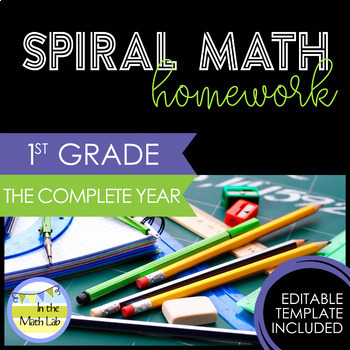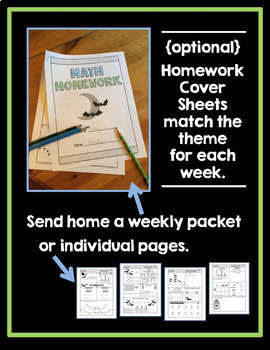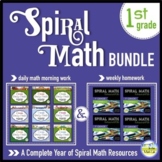1st Grade Math Homework COMPLETE YEAR BUNDLE Spiral Review
- Zip
What educators are saying
Products in this Bundle (5)
Also included in
- THANK YOU for your interest in this money-saving Spiral Math MEGA bundle! This MEGA BUNDLE includes:• 9 months (Sept - May) of Morning Work Daily Math packs• 36 weeks of Spiral Math HomeworkI don’t need to tell you how important it is to provide a steady spiral review of math concepts through the yePrice $64.99Original Price $93.96Save $28.97
Description
This is the COMPLETE YEAR of Spiral Math Homework for 1st Grade -- 36 weeks (9 weeks per quarter) of SPIRAL math review of all 1st Grade Common Core standards in a fun and comprehensive package.
Kids (and their parents) love this homework -- check out the reviews!
My students love these homework sets, and we're seeing nearly 100% completion rates--much better than ever before. I hope your students will LOVE them too!
★★ UNIQUE FEATURES OF THIS HOMEWORK: ★★
★ The Spiral Review -- new content is introduced each week, but previous content is also reviewed in a seamless manner. Constant review adds up to a more holistic approach to teaching math and better test scores. No more forgetting what they learned in September. Your students will be practicing the concepts all.year.long!
★ The Variety of Problem Types -- my homework sets offer lots of different kinds of problems--puzzles, error analysis, rigorous problem solving, specific strategy work, coloring, facts practice, drawing pictures, compare/contrast, and open-ended questions. My motto: keep kids thinking.
★ The Themes -- Every week has a new theme. Why is this important? Because themes keep the math relevant and related to real life. Kids are more motivated to do the math because the content is interesting and authentic. Themes also allow me to use related graphics (which are always fun) and sometimes weave in a story.
AND, if that's not enough, themes also allow me to weave in some social studies and science content -- interesting stuff!
★ The Word Problems -- our students need to be able to APPLY their math skills. They need to work with word problems all.year.long. And when these word problems have real-life contexts, it's a win-win! Students are naturally drawn into the story and interested in solving it. The problems are easier at first and gradually get more challenging as the year progresses.
★ Weekly Packet or Individual Pages? -- you decide! We send home weekly packets, with the cover sheet attached. We're finding that our kids like completing the "packet" and enjoy seeing the themed pages all together. Each student has a homework folder that includes the Tracking Sheet where they get to color in each day they complete. We have not experienced a lot of lost packets (but if they do lose them, we're prepared with fresh sets.) Also, the pages are formatted to accommodate a 3-hole punch, if you use homework notebooks. But, this resource is VERSATILE. You can certainly send home INDIVIDUAL pages, too.
Homework shouldn’t be boring – give your students homework they’ll want to do all.year.long.
TAKE A LOOK------> Download FREE Samples ⭐HERE.
⭐❤ FOLLOW ❤⭐ my store to hear about new product discounts and to get
exclusive freebies just for my followers.
๑ ๑ ๑ ๑ ๑ ๑ ๑ ๑ ๑ ๑ ๑ ๑ ๑ ๑ ๑ ๑ ๑ ๑ ๑ ๑ ๑ ๑ ๑ ๑ ๑ ๑ ๑ ๑ ๑ ๑ ๑ ๑ ๑ ๑ ๑ ๑ ๑ ๑ ๑ ๑ ๑ ๑ ๑ ๑
SPIRAL MATH HOMEWORK (THE COMPLETE YEAR) FEATURES
• 36 Weekly Sets of homework
• 4 days each week (Monday - Thursday)
• A new theme each week.
• {Optional} Homework Cover Sheets that match the theme for each week.
• Answer Keys for each day.
• {Optional} Homework Tracker page, where students color each day they complete.
• An editable PowerPoint Template for you to create additional pages, if you desire.
๑ ๑ ๑ ๑ ๑ ๑ ๑ ๑ ๑ ๑ ๑ ๑ ๑ ๑ ๑ ๑ ๑ ๑ ๑ ๑ ๑ ๑ ๑ ๑ ๑ ๑ ๑ ๑ ๑ ๑ ๑ ๑ ๑ ๑ ๑ ๑ ๑ ๑ ๑ ๑ ๑ ๑ ๑ ๑
These are some of the skills covered in each quarter. This is a SUGGESTED sequence. Since most of the themes are generic, you could opt to use the pages in a different order.
QUARTER 1
• Review of Key Kindergarten Skills
• Beginning Add/Sub Word Problems (1.OA.1)
• Commutative Prop. Addition (1.OA.3)
• Addition strategies: Counting On,
Counting Back within 10 and 20 (1.OA.1, 5, & 6)
• Counting 1s and 10s to 120 (1.NBT.1)
• One more, one less (1.NBT.1)
• 2-Digit Place Value, tens/ones (1.NBT.2)
• Compare 2-digit numbers (1.NBT.3)
• Interpret Bar/Picture Graphs
with up to 3 categories (1.MD.4)
QUARTER 2
• Spiral Review of all Quarter 1, AND
• More Add/Sub Word Problems (1.OA.1)
• Addition/Subtraction strategies:
Make Ten, add/sub relationship,
doubles plus 1 (1.OA.1, 5,&6)
• Add 3 addends (1.OA.2)
• Meaning of equal sign (1.OA.7)
• Unknown in any position (1.OA.8)
• Mentally add/sub 10 (1.NBT.5)
QUARTER 3
• Spiral Review of all Q1 and Q2, AND
• Comm/Assoc Properties of Add. (1.OA.3)
• Subtraction as Unknown Addend (1.OA.4)
• Add within 100 (1.NBT.4)
• Subtract multiples of 10 (1.NBT.6)
• Order objects by length (1.MD.1)
• Length w/nonstandard units (1.MD.2)
• Beg. time to hour (1.MD.3)
QUARTER 4
• Spiral Review of all Q1, Q2, Q3, AND
• Time to hour, half-hour (1.MD.3)
• Shapes – defining attributes (1.G.1)
• Composite shapes (1.G.2)
• Partition shapes into halves and
fourths (1.G.3)
๑ ๑ ๑ ๑ ๑ ๑ ๑ ๑ ๑ ๑ ๑ ๑ ๑ ๑ ๑ ๑ ๑ ๑ ๑ ๑ ๑ ๑ ๑ ๑ ๑ ๑ ๑ ๑ ๑ ๑ ๑ ๑ ๑ ๑ ๑ ๑ ๑ ๑ ๑ ๑ ๑ ๑ ๑ ๑
Try some of my other products:
Looking for a different grade? Homework sets are available for Grades 1 - 5.
Are you using my popular Spiral Daily Math series?
⭐Spiral Daily Math for 1st Grade: Sept-Dec Bundle
⭐Spiral Daily Math for 1st Grade: Jan-May Bundle
⭐Spiral Daily Math for 1st Grade – The Complete Set
1st Grade Math Assessments
⭐Math Assessments-ALL Standards
1st Grade Task Cards
⭐How Tall is My Dog? (Nonstandard Measurement Task Cards)
⭐Rosie's Bones (Measurement Task Cards)
⭐Number Words - Spell and Stamp
๑ ๑ ๑ ๑ ๑ ๑ ๑ ๑ ๑ ๑ ๑ ๑ ๑ ๑ ๑ ๑ ๑ ๑ ๑ ๑ ๑ ๑ ๑ ๑ ๑ ๑ ๑ ๑ ๑ ๑ ๑ ๑ ๑ ๑ ๑ ๑ ๑ ๑ ๑ ๑ ๑ ๑ ๑ ๑
LEAVE FEEDBACK on this product and earn 32 TPT credits to use on future purchases!
© In the Math Lab. Permission is granted to buyer for single classroom use. No part of this work may be put on the Internet, resold, or redistributed in any way.






